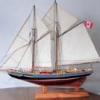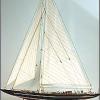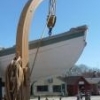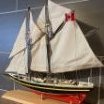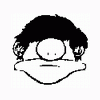MORE HANDBOOKS ARE ON THEIR WAY! We will let you know when they get here.
×
-
Posts
818 -
Joined
-
Last visited
Reputation Activity
-
 _SalD_ reacted to popeye the sailor in Andrea Gail by popeye the Sailor - FINISHED - 1:20 scale
_SalD_ reacted to popeye the sailor in Andrea Gail by popeye the Sailor - FINISHED - 1:20 scale
thanks again everyone for the kind comments and likes I'm only using that ladder, because I made it for the boat....the first attempt....and not like the others. they sport the round rungs. I'm still rather new to scratch building, and the first thing I came away with, is if you make an aspect in a certain way, all 'like' aspects should be done the same way. it gives uniformity throughout the entire build.
no fret on the finish of this one........I have two other fishing vessels in the wings. I've had urges to do something on them...but I can't seem to pull myself away from the A.G. I need to see this build done I also learned a few things from this build....some really cool stuff to throw at the others. I want to dwindle down my back log.......I have that Titanic......AND I have another special project in mind........sorry, can't go into it any deeper I can guarantee though...that you'll love it. I guess you can say that I'm way past the lament of the finished build........most likely another reason why I've accumulated the back log I have....I find {and have found} myself not waiting for the finish....and just mindlessly ramble on to the next one.
I'm glad your all enjoying this build........I'm enjoying sharing it with you here in this theater, that is MSW, we portray a play for all to see.......and our models are the stars. they don't do much, no lines to read.....and us, as the modelers, pull the strings, to make them perform.
at MSW, there spotlights a stage
where logs accumulate, page by page
narrated through the modeler's eye
it grows, it grows, as time goes by
no dance to do, no song to sing
but ships made from wood and string
we tell how it's built, cut and glue
we describe all the steps we do
but time goes by, and soon it is done
congrats and kind words from everyone
thanks MSW for all that you do
for allowing us to share them with you
....oh dear..........I think I've caught a bad case of poetry
.......well, how long have you had it?
...ohhhhhh, once upon a time!
>Monty Python<
-
 _SalD_ reacted to GuntherMT in Armed Virginia Sloop by GuntherMT - FINISHED - Model Shipways - scale 1:48
_SalD_ reacted to GuntherMT in Armed Virginia Sloop by GuntherMT - FINISHED - Model Shipways - scale 1:48
Been a little while, thank you for all of the kind words and likes.
Work has been extremely busy, so I have only spent a very small amount of time here and there on the AVS lately, but this morning I decided to make a few hours of time to put the poop deck to rest. I started trimming the planks for this part weeks ago, and just couldn't seem to get the time to finish.
For anyone else building a model with tapered planks like the poop deck of the AVS, I found a very simple jig in another AVS build log that works quite well for making the planks so they don't have to be done completely by hand, 26 times.
First up, I cut 28 pieces of plank to the appropriate length. I use a simple jig that I made to cut the hull planks to 4", and just measured and cut a new slot for cutting these planks:
The angle jig is surprisingly simple, but I don't think I would have thought of it if I hadn't seen it in another build log. I apologize for not giving proper credit, but I can't seem to locate it again right now.
The jig is made up of a 1/4" piece of wood that the deck plank lays against, 2 x 1/4" end pieces which are cut to length (sanded to final length after glue is dried) to give the proper taper, and a couple pieces of .030" (deck plank thickness) of planking placed to hold the deck plank in place, and also to support the straight edge used for cutting.
Place the plank into the jig, hold a straight edge up against the end 'stop' pieces, and then using very light pressure on the blade, simply cut along the straight edge to make tapered planks. I used a very thin steel straight edge for the actual cuts, the clear plastic one is for the photo only to show how it rests on the support planks.
Then, start placing planks!
Didn't take any other in-progress shots, it's just normal planking, but care must be taken to bevel the edges, as the curve of this deck will cause significant gapping if the planks are left straight edged.
Once complete there is a ledge left at the front end of the deck.
This ledge is a place for a moulding to go, which is supposed to be made out of walnut. However, I happened to have a piece of swiss pear that was almost exactly the right dimensions to make this moulding, so of course, I had to try it. I used a heat gun and pre-bent the curve into the wood so that it laid evenly all along the top edge of the deck, and then I beveled the back, and rounded the front. I also used a very sharp 2mm chisel to fine tune the front edge of the deck until I was happy with the fit along the edge.
And finally, I sanded to 320 grit, and applied a coat of wipe-on poly which is currently drying.
There are some fitment/gap issues along the top edges on both ends of the quarter deck wall, but I don't really see any way to fix them as they are built into the ship from mistakes made earlier in the contruction, so I'm just going to move on and hopefully they won't be very noticeable after the ship is finished with so much other stuff to catch the attention of the observer.
Next I think I need to assemble the cannon carriages.
-
 _SalD_ reacted to usedtosail in USS Constitution by usedtosail - FINISHED - Model Shipways - scale 1/76
_SalD_ reacted to usedtosail in USS Constitution by usedtosail - FINISHED - Model Shipways - scale 1/76
Thanks Tim, George, Rich and Steve, and the likes.
We were away last weekend and a few work related activities this week, so only a small amount of progress this week. I added all the pilasters to both quarter galleries, then focused on the port side gallery. I was able to use the supplied middle window, but I ended up making a new window for the rear one. I used the same method I used for the transom windows, first gluing the window frame strips to some paper, then making the mullions on the table saw and gluing them to the outer frame, then sanding off the paper when it was all dry. Here are the two windows dry fit in place before painting.
I painted them white and also painted the roof caps black with white sides. I first tried doing this free hand, but ended up cutting masking tape to the curve and using it to paint the white portion. Here are the windows and the cap in place on the port side, after gluing and trimming the floppy disk material to the backs of the windows.
I started adding some styrene strips for trim on the pilasters and underneath between the bottom block and the faring piece. I am matching these up to the two trim strips on the transom. I am also going to try adding a strip along the tops and bottoms of the windows after they are all installed. I started making the front window using the same method.
Finally, I made up a ladder to go into the hatch on the gun deck. I usually make these by hand by marking the locations of the stairs on the sides then filing out the slots for them. This time, I used the Byrnes saw to make the slots, using the miter gauge to change the angles very precisely from one side to the other. I made this task much easier and the ladder went together very easily.
I have to do a little work on my daughters car, but then I can get back to the workshop later today, so more progress coming soon.
-
 _SalD_ reacted to trippwj in Emma C Berry by trippwj - Model Shipways - Scale 1:32
_SalD_ reacted to trippwj in Emma C Berry by trippwj - Model Shipways - Scale 1:32
Greetings - and please accept my apology for the lengthy delay between posts! Between the snow onslaught in January and February and then my employment change last month, well, it has been rather difficult to get motivated to spend time in the build yard. Most of the progress shown was from January. I am trying to get my enthusiasm back to move on with Emma and hope to be splitting time between a side research project, the job search and the build table.
At any rate, the deck beams are nearly all in - 3 more major beams and a few cross pieces to add. I have opted not to do the knees - I tried a couple of times but they did not come out well at all.
View from above
Profile view. Note the very low clearance in the forward hold! The cabin will have a overall height just above the worker standing there.
Next up is install the last few deck beams and then start planking.
Suggestions desired - and thanks for stopping by!
-
 _SalD_ reacted to popeye the sailor in Andrea Gail by popeye the Sailor - FINISHED - 1:20 scale
_SalD_ reacted to popeye the sailor in Andrea Gail by popeye the Sailor - FINISHED - 1:20 scale
a strange turn of events.........the gangway ladder........yes! I did start on it....as I mentioned, I sized it, installed the locator tabs.......sanded it a bit more to define the rungs a bit more, drilled the holes for placement..... but the thought of assembling the aft section of the trawl rig, to the first section was stuck in my mind. taking a smaller dowel, and a number of dry fits { to be sure of the angle....proper or otherwise}, I was able to come up with the pair of support bars, I was going to need. I have a plan to assemble it, so it is still removable....it's just that it's going to be very 'tail heavy'.
first thing I did was cement the main deck ladder in place........I didn't bother with the roof ladder just yet.
it starts out with attaching the cables to the top of the gangway. once the aft section is cemented in place with the two support bars.....these will be attached. then it can be taken off the model, and patched together at the base, with mending plats on both sides {inner and outer}.
I was going to try and do the mending plates on the model, but I was afraid that cement might get under everything and adhere it to the deck. the port side cable is attached. that is also the reason why there is a clamp on the deck.....it popped off and went flying........good thing it didn't break anything!
when the starboard cable was attached......my idea went south! with it laying on the table, it was very unstable.......I was afraid it was going to break!
so I ended up doing an about face on that plan.........before I cemented it in place, I did the roof ladder first. I'll touch up both ladders later. I'll do the mending plates later as well, now that the base is firmly seated. the 'T' vent need to have some flat black swabbed in the vent holes........after that it was cemented in place.
so now..........it's touch up and lick my wounds....after this little escapade...... if I were to do a TV show, I think I'd call it "Plan gone Wild" ! the only real bad point about this, is that now if I need to drill any holes and stuff.....I'll have to do it on the boat. ahhhh, what the heck........at least I have it on there now
-
 _SalD_ got a reaction from EricWilliamMarshall in US Brig Syren by _SalD_ – FINISHED - 3/16" scale
_SalD_ got a reaction from EricWilliamMarshall in US Brig Syren by _SalD_ – FINISHED - 3/16" scale
After a little procrastination I started plating the hull. For me, plating is a little like taking a bath when you’re a kid, you hate to get in but once you are you hate to get out. To start I cut 30” long strips of copper tape to put through the jig. I then cut that strip into smaller more manageable segments. I have to say that the chisel blade on the stamp worked out very well. Before I started the coppering I attached a temporary piece of wood to the deck so I could hold the ship in my keel vise. This made it much easier to work on the inverted hull. The screws holding the wood are positioned where the hatches will go and the deck will be repaired after the wood piece is removed.
The actual plating went well with no major boo boos. In fact I found this ship to be easier than when I did the Phantom’s plates. Not as much cutting of the plates and the larger size plates are easier to handle. To keep finger prints off the copper I wore latex gloves and to fix the plates in place I went over them with a wallpaper seam roller. Please excuse the photos, it's hard taking good pictures of the plates
Started with the keel
Continuing on
Finished the port side
No dressing belt yet
When I got to the dressing belts I thought to myself, self, the only real difference between the hull plates and the dressing belt are four additional holes along the top of the plate. So instead of making two new stamps for the dressing belt plates, even though I had all the material ready to make them, I just used a burnishing tool to place the four additional holes in the plates I already had. One thing I found that helped a lot with placing the dressing belt that I really didn't plan but worked out well was that when I painted the waterline I had taped off it's exact location. Afterwards I thought it would be a good idea if I painted a little below the waterline to give me some room for errors. What happened was I got a nice tape line marking the position of the waterline between the two applications of the black paint.
Dressing belt
Started the starboard side Finished the starboard
Done, time to get out of the tub , on to the rudder
-
 _SalD_ got a reaction from canoe21 in US Brig Syren by _SalD_ – FINISHED - 3/16" scale
_SalD_ got a reaction from canoe21 in US Brig Syren by _SalD_ – FINISHED - 3/16" scale
Chapter 8 – coppering the hull
Prior to coppering the hull I need to make the stamps for the simulated nail heads in the copper plates. I will be using the nail pattern that Chuck shows in the instructions for the port and starboard plates and after studying Dirk’s (Dubz) build I will be making two additional stamps for the port and starboard dressing belts. The patterns were drawn to 3/16” scale using AutoCAD.
For the pins I used 26 gauge Lancets, bought at Wal-Mart, as mentioned in Richard’s (rtropp) and Thomas’s (Gahm) builds. I went with the thicker 26 gauge lancets and not the 30 gauge as Thomas used because I wasn’t showing as many nails he did. Extracting the needle from the plastic holder proved to be a challenge and what I finally did was; using my propane torch I heated the metal tip thus softening the plastic around the needle so it could be pulled out easier. Disclaimer: If you use this technique please be aware that the plastic does burn so use caution and have a cup of water on hand to place the plastic holder in.
I used some scrap poplar to make the stamp and cut it to the dimensions shown in the instructions. I glued the nail pattern on it as a guide and then I got to use the Christmas present from the Admiral (Proxxon drill press with compound table).
After drilling all the holes I inserted the pins and glued them in. Prior to inserting them I did cut about a ¼” off the needles (sharp end) so they wouldn’t stick out so much. One modification I made to the stamp was to attach an X-Acto chisel blade to one end of the stamp at the same height as the pins. I believe it’s a #17 blade and it fit the ¼” wide stamp perfectly. I attached the blade to mark the copper where I would need to make the cut for the individual plates, I found however that by applying just the right amount of force the blade will cut the copper but not the paper backing. I also made the opening in the jig a 1/16” larger to account for the blade thickness.
-
 _SalD_ got a reaction from EricWilliamMarshall in US Brig Syren by _SalD_ – FINISHED - 3/16" scale
_SalD_ got a reaction from EricWilliamMarshall in US Brig Syren by _SalD_ – FINISHED - 3/16" scale
Augie, George, RR, Thomas, thanks for the kind words. I also find this task to be rewarding and relaxing especially when it turns out nice. For my Phantom I didn’t do anything special for the copper and it seems to be darkening nicely but I did get a lot of finger prints on it while completing the model. If I do leave it ‘au naturel’ my only concern is keeping my grubby fingers off it while finishing it.
Augie it's a date 25 years from now I'll post a picture.
And thanks to all for the likes.
-
 _SalD_ got a reaction from augie in US Brig Syren by _SalD_ – FINISHED - 3/16" scale
_SalD_ got a reaction from augie in US Brig Syren by _SalD_ – FINISHED - 3/16" scale
Augie, George, RR, Thomas, thanks for the kind words. I also find this task to be rewarding and relaxing especially when it turns out nice. For my Phantom I didn’t do anything special for the copper and it seems to be darkening nicely but I did get a lot of finger prints on it while completing the model. If I do leave it ‘au naturel’ my only concern is keeping my grubby fingers off it while finishing it.
Augie it's a date 25 years from now I'll post a picture.
And thanks to all for the likes.
-
 _SalD_ reacted to GLakie in Andrea Gail by popeye the Sailor - FINISHED - 1:20 scale
_SalD_ reacted to GLakie in Andrea Gail by popeye the Sailor - FINISHED - 1:20 scale
No worries Dennis! I'm like a bad tick. Pretty hard to ignore, or get rid of.
-
 _SalD_ got a reaction from Canute in US Brig Syren by _SalD_ – FINISHED - 3/16" scale
_SalD_ got a reaction from Canute in US Brig Syren by _SalD_ – FINISHED - 3/16" scale
Augie, George, RR, Thomas, thanks for the kind words. I also find this task to be rewarding and relaxing especially when it turns out nice. For my Phantom I didn’t do anything special for the copper and it seems to be darkening nicely but I did get a lot of finger prints on it while completing the model. If I do leave it ‘au naturel’ my only concern is keeping my grubby fingers off it while finishing it.
Augie it's a date 25 years from now I'll post a picture.
And thanks to all for the likes.
-
 _SalD_ reacted to CaptMorgan in US Brig Syren by _SalD_ – FINISHED - 3/16" scale
_SalD_ reacted to CaptMorgan in US Brig Syren by _SalD_ – FINISHED - 3/16" scale
Sweet -- very nicely done. I'm still paying close attention....
-
 _SalD_ reacted to Gahm in US Brig Syren by _SalD_ – FINISHED - 3/16" scale
_SalD_ reacted to Gahm in US Brig Syren by _SalD_ – FINISHED - 3/16" scale
The coppered hull of your Syren looks great! I found this to be one of the most satisfying parts of the building process. And where the finishing process is concerned I belong to the more lazy guys and let mother nature do it. One piece less I can mess up
Thomas
-
 _SalD_ got a reaction from canoe21 in US Brig Syren by _SalD_ – FINISHED - 3/16" scale
_SalD_ got a reaction from canoe21 in US Brig Syren by _SalD_ – FINISHED - 3/16" scale
After a little procrastination I started plating the hull. For me, plating is a little like taking a bath when you’re a kid, you hate to get in but once you are you hate to get out. To start I cut 30” long strips of copper tape to put through the jig. I then cut that strip into smaller more manageable segments. I have to say that the chisel blade on the stamp worked out very well. Before I started the coppering I attached a temporary piece of wood to the deck so I could hold the ship in my keel vise. This made it much easier to work on the inverted hull. The screws holding the wood are positioned where the hatches will go and the deck will be repaired after the wood piece is removed.
The actual plating went well with no major boo boos. In fact I found this ship to be easier than when I did the Phantom’s plates. Not as much cutting of the plates and the larger size plates are easier to handle. To keep finger prints off the copper I wore latex gloves and to fix the plates in place I went over them with a wallpaper seam roller. Please excuse the photos, it's hard taking good pictures of the plates
Started with the keel
Continuing on
Finished the port side
No dressing belt yet
When I got to the dressing belts I thought to myself, self, the only real difference between the hull plates and the dressing belt are four additional holes along the top of the plate. So instead of making two new stamps for the dressing belt plates, even though I had all the material ready to make them, I just used a burnishing tool to place the four additional holes in the plates I already had. One thing I found that helped a lot with placing the dressing belt that I really didn't plan but worked out well was that when I painted the waterline I had taped off it's exact location. Afterwards I thought it would be a good idea if I painted a little below the waterline to give me some room for errors. What happened was I got a nice tape line marking the position of the waterline between the two applications of the black paint.
Dressing belt
Started the starboard side Finished the starboard
Done, time to get out of the tub , on to the rudder
-
 _SalD_ reacted to GuntherMT in Indian Girl Canoe by GuntherMT - FINISHED - Midwest Products - Scale 1:12 - SMALL
_SalD_ reacted to GuntherMT in Indian Girl Canoe by GuntherMT - FINISHED - Midwest Products - Scale 1:12 - SMALL
And so it continues. I was working from home today, as work is sort of a mess right now, but the nice thing about working from home is that I can pretty much keep my own schedule, and I can go do a bit on the boat, and then go work while I'm waiting for something to dry for the next step. Working like that is sort of a pain, but it does allow me to make slow progress even when I don't have time to sit down and plank the poop-deck of the AVS.
After cleaning up the ribs a bit, the next items on the agenda are the in-wale and gun-wale. These are made with cherry strips in the kit. The in-wale is pretty straight forward, trim the strip to length and glue it along the top of the ribs between the two end decks. No particular issues other than accidentally cutting one a bit too short and having to insert a shim. Oops. Only 1 spare strip of cherry, so I didn't use it since the gun-wales would be the real challenge (this turned out to be the right decision).
Here the in-wales are both placed and glued up. I went back to the white PVA glue for this.
The next step was the gun-wales, which turned out to be what is likely the most challenging part of this kit for a new modeler, as it certainly was for me. The cherry strips are 1/8" x 1/16", and they need to be tapered for the final 3-1/2" of the ends of the gun-wale to a 1/32" square. So they need to taper in both dimensions, to an extremely fine point, and then they have to be bent to fit the curve of the deck! Cherry isn't nearly as flexible as basswood.
The instructions say to soak the planks in a 50/50 ammonia/water mix and then super glue one end, follow the curve of the hull, and then at some nebulous point, trim the other end to length and taper it. Umm.. yea, sure, that will work great! Or maybe not.
I chose to taper one end of the plank, then use the "Chuck" bending system to get it shaped to follow one end of the hull. Chuck's system is pretty simple, using 3 clamps and a board, you apply heat to the bent plank (I use a heat gun, Chuck demonstrated with a hair dryer), and then let it cool. When you un-clamp it, there is very little spring-back.
After getting one end shaped, I clamped it in place, all the way along the edge of the hull, and then marked where to cut the other end off, tapered the other end, and then bent it to shape. After I was happy with the curve at both ends, I glued the plank in place and clamped it.
While sanding the taper on one end, I managed to snap one of the planks in two about 1/3 of the way down. So much for a spare plank!
Luckily I managed to get two of them done without breaking another one, and got them in place. Once they are glued in place, I sanded down the top of the wales to be even with the hull from end to end. And that's where it is now.
The next items in the kit are the thwarts, and the seats. After that comes the paddles and it's finished. I'm going to play some finishing games though, and I think I'll do that prior to placing anything else into the canoe, so it will probably be a bit before there is another update, as the finish will take a week or more to complete due to drying between layers.
Hopefully I'll have the 'finish reveal' by next weekend.
In the meantime, I'll get to planking the poop-deck of the AVS tomorrow I think. Just need to figure out a good way to make a jig to cut 26 identical tapered planks for that.
Cheers!
-
 _SalD_ reacted to augie in US Brig Syren by _SalD_ – FINISHED - 3/16" scale
_SalD_ reacted to augie in US Brig Syren by _SalD_ – FINISHED - 3/16" scale
Dirks log also listed a vinegar/salt mixture that seemed to work quite well. And I've seen some take off the shine with dullcoat.
Mine's been coppered for about 2 years now. I didn't do anything special and the color is darkening/ageing naturally. Let's all touch base in 25 years and see how they all turn out.
-
 _SalD_ got a reaction from jdbradford in US Brig Syren by _SalD_ – FINISHED - 3/16" scale
_SalD_ got a reaction from jdbradford in US Brig Syren by _SalD_ – FINISHED - 3/16" scale
After a little procrastination I started plating the hull. For me, plating is a little like taking a bath when you’re a kid, you hate to get in but once you are you hate to get out. To start I cut 30” long strips of copper tape to put through the jig. I then cut that strip into smaller more manageable segments. I have to say that the chisel blade on the stamp worked out very well. Before I started the coppering I attached a temporary piece of wood to the deck so I could hold the ship in my keel vise. This made it much easier to work on the inverted hull. The screws holding the wood are positioned where the hatches will go and the deck will be repaired after the wood piece is removed.
The actual plating went well with no major boo boos. In fact I found this ship to be easier than when I did the Phantom’s plates. Not as much cutting of the plates and the larger size plates are easier to handle. To keep finger prints off the copper I wore latex gloves and to fix the plates in place I went over them with a wallpaper seam roller. Please excuse the photos, it's hard taking good pictures of the plates
Started with the keel
Continuing on
Finished the port side
No dressing belt yet
When I got to the dressing belts I thought to myself, self, the only real difference between the hull plates and the dressing belt are four additional holes along the top of the plate. So instead of making two new stamps for the dressing belt plates, even though I had all the material ready to make them, I just used a burnishing tool to place the four additional holes in the plates I already had. One thing I found that helped a lot with placing the dressing belt that I really didn't plan but worked out well was that when I painted the waterline I had taped off it's exact location. Afterwards I thought it would be a good idea if I painted a little below the waterline to give me some room for errors. What happened was I got a nice tape line marking the position of the waterline between the two applications of the black paint.
Dressing belt
Started the starboard side Finished the starboard
Done, time to get out of the tub , on to the rudder
-
 _SalD_ got a reaction from jdbradford in US Brig Syren by _SalD_ – FINISHED - 3/16" scale
_SalD_ got a reaction from jdbradford in US Brig Syren by _SalD_ – FINISHED - 3/16" scale
Chapter 8 – coppering the hull
Prior to coppering the hull I need to make the stamps for the simulated nail heads in the copper plates. I will be using the nail pattern that Chuck shows in the instructions for the port and starboard plates and after studying Dirk’s (Dubz) build I will be making two additional stamps for the port and starboard dressing belts. The patterns were drawn to 3/16” scale using AutoCAD.
For the pins I used 26 gauge Lancets, bought at Wal-Mart, as mentioned in Richard’s (rtropp) and Thomas’s (Gahm) builds. I went with the thicker 26 gauge lancets and not the 30 gauge as Thomas used because I wasn’t showing as many nails he did. Extracting the needle from the plastic holder proved to be a challenge and what I finally did was; using my propane torch I heated the metal tip thus softening the plastic around the needle so it could be pulled out easier. Disclaimer: If you use this technique please be aware that the plastic does burn so use caution and have a cup of water on hand to place the plastic holder in.
I used some scrap poplar to make the stamp and cut it to the dimensions shown in the instructions. I glued the nail pattern on it as a guide and then I got to use the Christmas present from the Admiral (Proxxon drill press with compound table).
After drilling all the holes I inserted the pins and glued them in. Prior to inserting them I did cut about a ¼” off the needles (sharp end) so they wouldn’t stick out so much. One modification I made to the stamp was to attach an X-Acto chisel blade to one end of the stamp at the same height as the pins. I believe it’s a #17 blade and it fit the ¼” wide stamp perfectly. I attached the blade to mark the copper where I would need to make the cut for the individual plates, I found however that by applying just the right amount of force the blade will cut the copper but not the paper backing. I also made the opening in the jig a 1/16” larger to account for the blade thickness.
-
 _SalD_ got a reaction from CharlieZardoz in US Brig Syren by _SalD_ – FINISHED - 3/16" scale
_SalD_ got a reaction from CharlieZardoz in US Brig Syren by _SalD_ – FINISHED - 3/16" scale
I was a little disappointed in the way I finished the deck and I learned what not to do next time. I drilled all the holes for the treenails prior to staining the deck which in hind sight I don’t think was a good idea. Prior to staining the deck I stained a test strip with holes in it similar to the deck and found that the stain was bleeding into the holes making a dark ring at each hole. To avoid this I filled all the holes with wood filler before staining. There was no bleeding into the holes but the stain was a little blotchy (yes Augie I tried pre-stain this time). I believe it was from not sanding the deck enough to remove all the wood filler that was on the surface. I was a little reluctant to sand too much in fear of sanding through the deck plank but again in hind sight there was plenty of material left to sand.
For the treenails I decided to show only the treenails located along the deck beams where I had a butt joint and not at every beam between the bulkheads. I thought it would be too much, not to mention I didn’t want to drill all those holes. The only problem was that after I filled them with wood filler and stained the deck the treenails didn’t show up too well. I may redo them.
For the waterway I tried a few different procedures to make the triangular chamfer strip from the 1/16” square stock. There is probably a real simple way of doing this but what I came up with was; first I cut a V-groove in a piece of scrap pine using a V gouge, making the depth of the groove slightly less than the finished shape of the waterway. Next I taped two erasing shields on either side of the groove to avoid sanding into the pine. The shields are 0.1 mm thick. Then I laid the wood strip in the groove and removed the top half using my dremel’s drum sanding attachment. What was left was a nice 1/16” X 1/16” chamfer strip.
-
 _SalD_ got a reaction from Landlocked123 in US Brig Syren by _SalD_ – FINISHED - 3/16" scale
_SalD_ got a reaction from Landlocked123 in US Brig Syren by _SalD_ – FINISHED - 3/16" scale
After a little procrastination I started plating the hull. For me, plating is a little like taking a bath when you’re a kid, you hate to get in but once you are you hate to get out. To start I cut 30” long strips of copper tape to put through the jig. I then cut that strip into smaller more manageable segments. I have to say that the chisel blade on the stamp worked out very well. Before I started the coppering I attached a temporary piece of wood to the deck so I could hold the ship in my keel vise. This made it much easier to work on the inverted hull. The screws holding the wood are positioned where the hatches will go and the deck will be repaired after the wood piece is removed.
The actual plating went well with no major boo boos. In fact I found this ship to be easier than when I did the Phantom’s plates. Not as much cutting of the plates and the larger size plates are easier to handle. To keep finger prints off the copper I wore latex gloves and to fix the plates in place I went over them with a wallpaper seam roller. Please excuse the photos, it's hard taking good pictures of the plates
Started with the keel
Continuing on
Finished the port side
No dressing belt yet
When I got to the dressing belts I thought to myself, self, the only real difference between the hull plates and the dressing belt are four additional holes along the top of the plate. So instead of making two new stamps for the dressing belt plates, even though I had all the material ready to make them, I just used a burnishing tool to place the four additional holes in the plates I already had. One thing I found that helped a lot with placing the dressing belt that I really didn't plan but worked out well was that when I painted the waterline I had taped off it's exact location. Afterwards I thought it would be a good idea if I painted a little below the waterline to give me some room for errors. What happened was I got a nice tape line marking the position of the waterline between the two applications of the black paint.
Dressing belt
Started the starboard side Finished the starboard
Done, time to get out of the tub , on to the rudder
-
 _SalD_ got a reaction from mspringer in US Brig Syren by _SalD_ – FINISHED - 3/16" scale
_SalD_ got a reaction from mspringer in US Brig Syren by _SalD_ – FINISHED - 3/16" scale
After a little procrastination I started plating the hull. For me, plating is a little like taking a bath when you’re a kid, you hate to get in but once you are you hate to get out. To start I cut 30” long strips of copper tape to put through the jig. I then cut that strip into smaller more manageable segments. I have to say that the chisel blade on the stamp worked out very well. Before I started the coppering I attached a temporary piece of wood to the deck so I could hold the ship in my keel vise. This made it much easier to work on the inverted hull. The screws holding the wood are positioned where the hatches will go and the deck will be repaired after the wood piece is removed.
The actual plating went well with no major boo boos. In fact I found this ship to be easier than when I did the Phantom’s plates. Not as much cutting of the plates and the larger size plates are easier to handle. To keep finger prints off the copper I wore latex gloves and to fix the plates in place I went over them with a wallpaper seam roller. Please excuse the photos, it's hard taking good pictures of the plates
Started with the keel
Continuing on
Finished the port side
No dressing belt yet
When I got to the dressing belts I thought to myself, self, the only real difference between the hull plates and the dressing belt are four additional holes along the top of the plate. So instead of making two new stamps for the dressing belt plates, even though I had all the material ready to make them, I just used a burnishing tool to place the four additional holes in the plates I already had. One thing I found that helped a lot with placing the dressing belt that I really didn't plan but worked out well was that when I painted the waterline I had taped off it's exact location. Afterwards I thought it would be a good idea if I painted a little below the waterline to give me some room for errors. What happened was I got a nice tape line marking the position of the waterline between the two applications of the black paint.
Dressing belt
Started the starboard side Finished the starboard
Done, time to get out of the tub , on to the rudder
-
 _SalD_ got a reaction from canoe21 in US Brig Syren by _SalD_ – FINISHED - 3/16" scale
_SalD_ got a reaction from canoe21 in US Brig Syren by _SalD_ – FINISHED - 3/16" scale
I was a little disappointed in the way I finished the deck and I learned what not to do next time. I drilled all the holes for the treenails prior to staining the deck which in hind sight I don’t think was a good idea. Prior to staining the deck I stained a test strip with holes in it similar to the deck and found that the stain was bleeding into the holes making a dark ring at each hole. To avoid this I filled all the holes with wood filler before staining. There was no bleeding into the holes but the stain was a little blotchy (yes Augie I tried pre-stain this time). I believe it was from not sanding the deck enough to remove all the wood filler that was on the surface. I was a little reluctant to sand too much in fear of sanding through the deck plank but again in hind sight there was plenty of material left to sand.
For the treenails I decided to show only the treenails located along the deck beams where I had a butt joint and not at every beam between the bulkheads. I thought it would be too much, not to mention I didn’t want to drill all those holes. The only problem was that after I filled them with wood filler and stained the deck the treenails didn’t show up too well. I may redo them.
For the waterway I tried a few different procedures to make the triangular chamfer strip from the 1/16” square stock. There is probably a real simple way of doing this but what I came up with was; first I cut a V-groove in a piece of scrap pine using a V gouge, making the depth of the groove slightly less than the finished shape of the waterway. Next I taped two erasing shields on either side of the groove to avoid sanding into the pine. The shields are 0.1 mm thick. Then I laid the wood strip in the groove and removed the top half using my dremel’s drum sanding attachment. What was left was a nice 1/16” X 1/16” chamfer strip.
-
 _SalD_ got a reaction from PaddyO in US Brig Syren by _SalD_ – FINISHED - 3/16" scale
_SalD_ got a reaction from PaddyO in US Brig Syren by _SalD_ – FINISHED - 3/16" scale
Ship is all repainted and ready for the deck.
-
 _SalD_ got a reaction from Jaggy in US Brig Syren by _SalD_ – FINISHED - 3/16" scale
_SalD_ got a reaction from Jaggy in US Brig Syren by _SalD_ – FINISHED - 3/16" scale
Finished the inboard planking and gave it a couple coats of paint.
I made the cap rail in one piece from a basswood sheet that was 3”x24”x1/16” thick. I used a heavy card stock to trace the top of the bulwarks instead of the wood sheet itself because it was a bit more flexible than the wood and less expensive if I messed it up. I cut the card stock pattern out, traced it on the wood sheet and then cut the rail out with an x-acto knife and sanded smooth.
While the cap rail glue was drying I made the 1/16” square molding strips that go along the outboard edge of the cap rail. I pretty much made these strips similar to the smaller molding strips at the stern by using my drafting triangles to hold the strip steady, then scoring the wood with an x-acto knife and then forming the groove with the compass point held in a mechanical pencil. The only difference was that for these strips I borrowed an idea from Richard’s (rtropp) build log and used a small piece of sandpaper folded in half to clean up the groove.
Before I start the decking I’m going to repaint everything (where's Earl Scheib when you need him) . The sheer plank, the stern cap rail and the upper wale got pretty beat up while installing the inboard planking and cap rail. Now I know why Dirk recommended not painting the black until everything was installed. Live and learn.
-
 _SalD_ got a reaction from canoe21 in US Brig Syren by _SalD_ – FINISHED - 3/16" scale
_SalD_ got a reaction from canoe21 in US Brig Syren by _SalD_ – FINISHED - 3/16" scale
After chapter 5, chapter 6 seemed like a breeze. I carved the groove in the molding strips using the method Chuck describes in chapter 10. I don’t have a picture of it but to secure the strip while I carved it I sandwiched it in between to drafting triangles taped to the table top. After carving them I made up a little jig to pre-form the strps to the correct curve. Once they were dry I glued them in place.
On the second layer transom I needed to sand down the inside edge somewhat. This is because when it was held in place it overlapped the upper outboard corners of both gun ports. When sanding it down I took the liberty to shape it a little differently by increasing the width between the ports. I thought it might help when placing the carving on it.
Next I attempted to bend the stern cap rail. I’ll let the pictures speak for themselves.
First attempt. Thought I could do better.
Second attempt. Thought I knew what I was doing.
Like they say, third times a charm.
Satisfied with the cap rail I made the fashion piece(s). Again like the first layer fashion piece I made it in one piece.
Glued it all together, filled the gaps with wood filler, sanded it, couple coats of paint and finished with chapter 6.


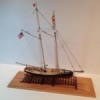
.thumb.jpeg.fc5d633a7b34428fcf19419a73d56d55.jpeg)
